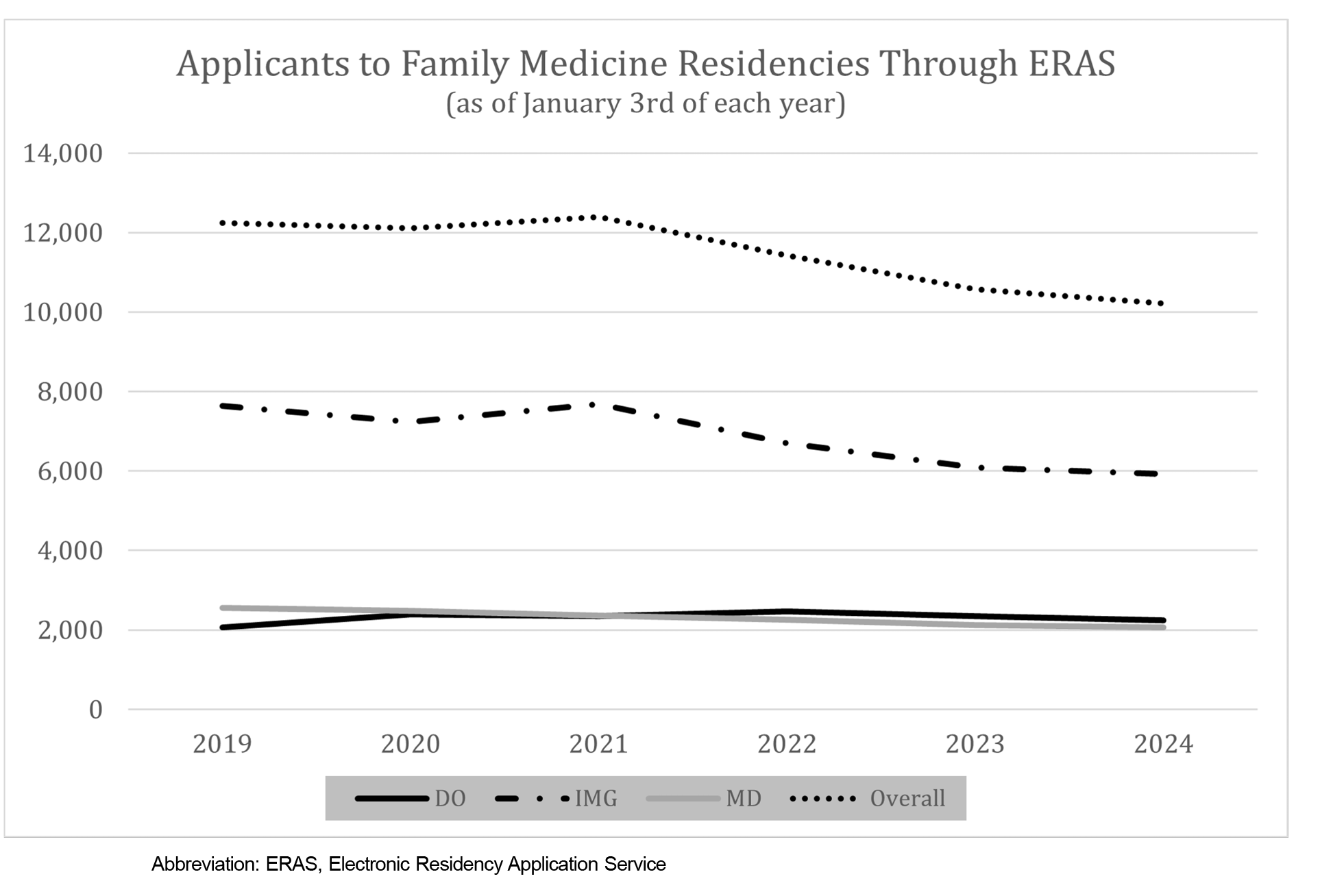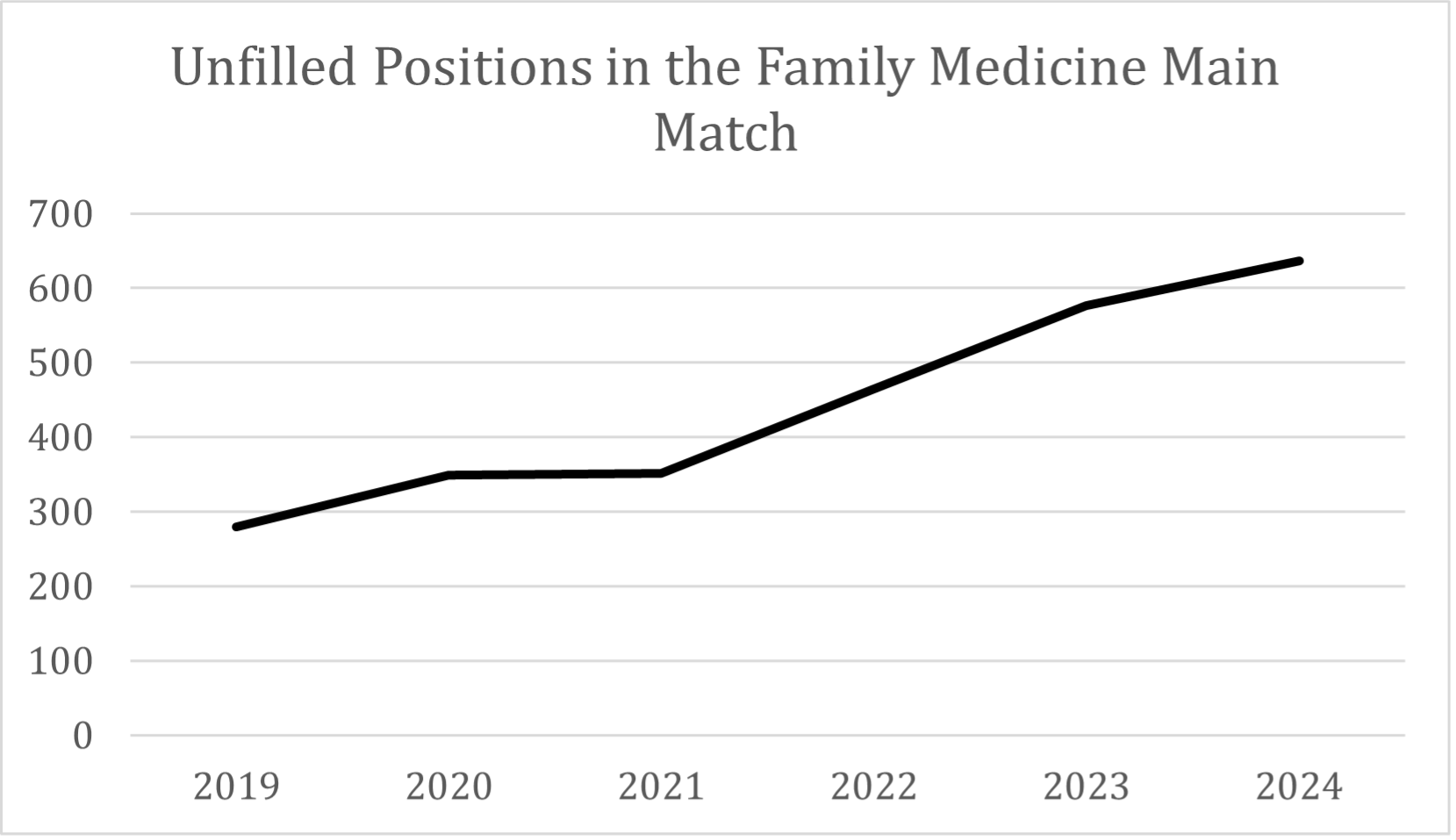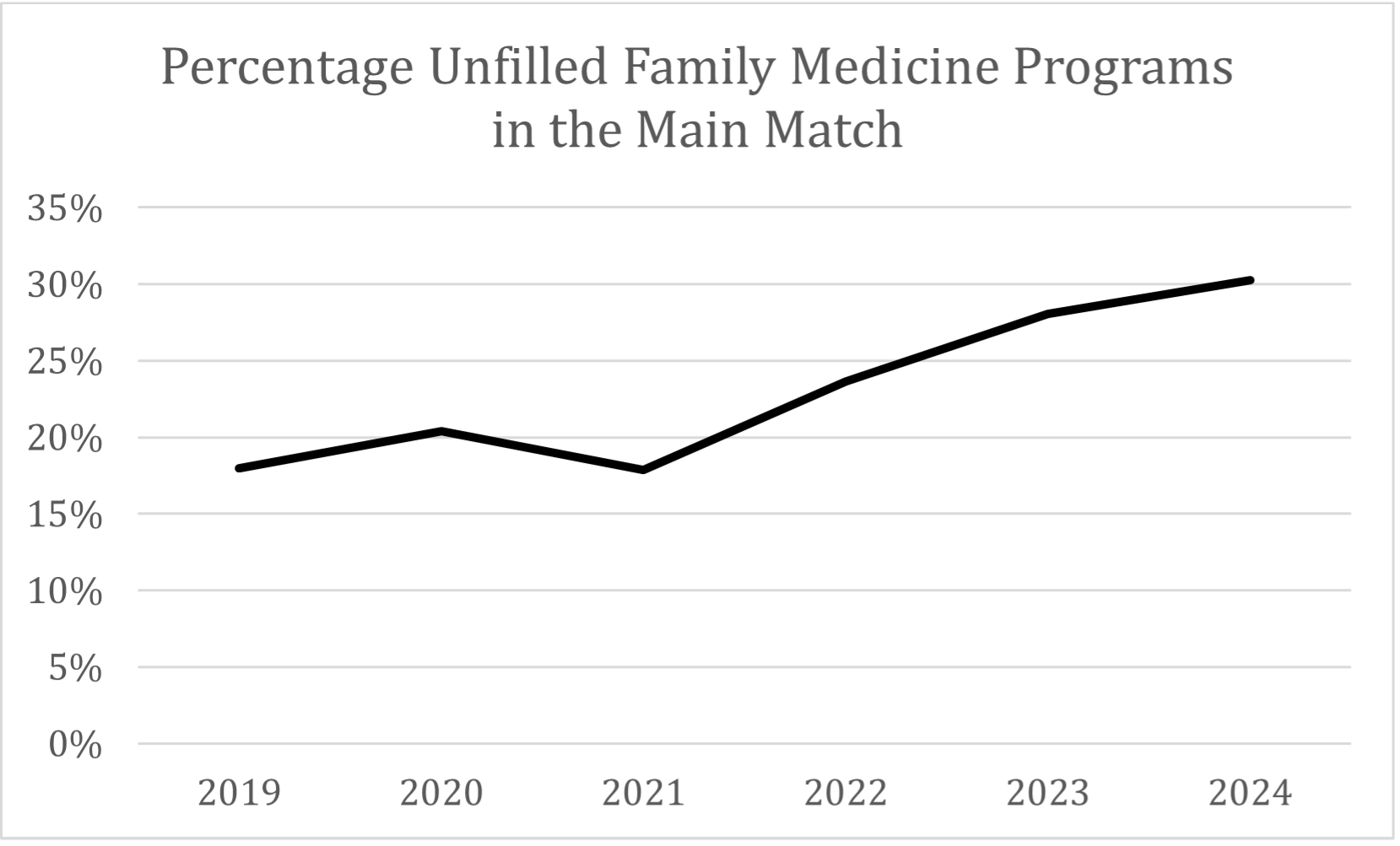Background and Objectives: The number of family medicine positions unfilled in the Main Match has increased from 2019 to 2023. In the 2023–2024 family medicine application season, the specialty adopted the changes in the Electronic Residency Application Service (ERAS or MyERAS), which included geographic preferences and offered applicants five program signals. We compared the number of unfilled positions from prior years to results of the 2024 family medicine Match after the adoption of these changes.
Methods: We analyzed publicly available data from the National Resident Matching Program to compare the number of positions filled in the Main Match from 2019 to 2024. We estimated the number of expected positions filled using multiple linear regression and application data from ERAS and the number of available positions in the Match.
Results: A total of 636 positions were unfilled in the 2024 family medicine Main Match. Our statistical analysis, based only on the number of applicants and the number of available positions, predicted 630.65 unfilled slots with a 95% confidence interval from 605.53 to 655.77. The 2024 family medicine position fill rate decreased slightly at 87.8% compared to 88.7% in the 2023 Match. The number of family medicine programs that did not fill in the Main Match increased in 2024 to 241 (30.3% of programs) compared to 217 (28.1%) in 2023.
Conclusions: MyERAS changes in the 2023-2024 family medicine application season, including geographic preferences and program signaling, were not associated with a change in the number of programs or positions filled in the family medicine Main Match.
The health of the public in the United States depends on a strong primary care infrastructure and a robust supply of primary care physicians. 1 In 2023, 4,511 students and graduates matched to US Accreditation Council for Graduate Medical Education-approved categorical family medicine residencies through the Main Match of the National Resident Matching Program (NRMP). 2, 3 While the number of US DO students matching to family medicine residencies is at an all-time high, the number of US MD seniors matching to family medicine remains substantially below the all-time high of 2,340 in 1997. 2
The number of family medicine residency programs continues to expand. In the 2023 Match, the specialty of family medicine offered 5,088 positions in 773 residency programs.3 Both of these numbers were the highest in the history of the specialty of family medicine.2 However, the Match fill rate of 88.7% (percentage of available positions filled in the Main Residency Match) was the lowest in family medicine since 2007. 2 Positions in 217 programs were unfilled (577 slots) in the Main Residency Match in 2023, representing 28.1% of all family medicine programs.3 Most of these positions were subsequently filled in the NRMP’s Supplemental Offer and Acceptance Program.
The number of applicants to family medicine residencies is decreasing 4 (Figure 1). As of January 3 of each application year, the total number of applicants to family medicine residencies declined from 10,570 in the 2023 season to 10,213 in the 2024 season, a 3.4% drop. From January 3, 2019, to January 3, 2024, the total number of applicants to family medicine residencies has decreased from 12,246 to 10,213, a decline of 16.6%.
To help programs and applicants find an optimal fit in a high-volume application environment, the American Association of Medical Colleges (AAMC) developed the Electronic Residency Application Service (ERAS or MyERAS) supplemental application. The supplemental application was introduced from 2020 to 2023 in many specialties to investigate possible application improvements. Family medicine did not participate in the ERAS supplemental application pilot. Based on “research findings from the successful supplemental ERAS application,”5 AAMC introduced the new MyERAS for the 2023–2024 application and Match season. The purpose of the changes to the ERAS application were to “allow applicants to describe their most meaningful experiences,” to “indicate geographic preferences,” and to “signal programs about their interests.”5 Programs are expected to benefit from the new myERAS to “identify applicants who are genuinely interested in their programs and whose interests and experiences align with their programs’ setting, mission, and goals.”5 The specialty of family medicine participated in the new myERAS in the 2023–2024 application, interview, and Match season, offering applicants an opportunity to signal up to five programs.
The impact of changes to the ERAS application, including program signaling, on Match rates and unfilled positions in the specialty of family medicine are uncertain. This study aimed to assess the association of MyERAS changes, including geographic preferences and program signaling, on the Match rate for programs and applicants in the 2024 NRMP Match.
We reviewed publicly available NRMP Match data from 2019 to 2024, including data from Match week March 2024. 6 We used multiple linear regression to test whether the number of applications to family medicine residencies and the number of family medicine positions offered significantly predicted the number of categorical family medicine matches.
We examined a histogram of regression residuals and a residual scatterplot to detect violations of homoscedasticity and linearity. The residuals were roughly normally distributed. We calculated the variance inflation factor value of the two predictors to assess the presence of collinearity.
No institutional review board approval was sought because all data are publicly available.
In the 2024 Match, 5,213 family medicine positions were offered. Of these positions, 4,577 were filled in the Main Match; 636 positions were unfilled (Figure 2). The 2024 family medicine position fill rate decreased slightly at 87.8% compared to 88.7% in the 2023 Match.
The number of family medicine programs that did not fill in the Main Match increased in 2024 to 241 (30.3% of programs) compared to 217 (28.1%) in 2023 (Figure 3).
For the 2019–2023 data, the results of the multiple linear regression with applications and positions as predictors showed the utility of the predictive model was statistically significant (R
2=0.99, F[2,2]=2,587.87, P=<.000) with the predictors of applications and positions explaining most of the variance between the variables (99%).
Using this model, the predicted number of categorical family medicine matches for the 2024 Match would be 4,582.35, with a 95% confidence interval ranging from 4,557.23 to 4,607.47 with an anticipated 630.65 unfilled positions on Match day.
The actual categorical number of family medicine matches (4,577) compared to the model predicted number (4,582.35) deviated by +5.35 (<1%).
Overall, the diagnostic checks, including the analysis of residuals, confirmed the model’s adherence to the assumptions of multiple linear regression.
The 2023–2024 changes to the MyERAS application, including program signaling and geographic preferences, were not associated with a decrease in unfilled programs or in the number of unfilled positions in the family medicine Match. The number of matches was precisely predicted by the number of applications and the number of available positions.
The reason that program signals and geographic preferences had no impact on Match fill rate are unclear. The first year of use of signals in family medicine was 2023–2024. A latency effect could exist as programs determine their best use of signals. Additionally, family medicine has more residency programs than any other specialty, with many small programs spaced over a wide geographic area. The number and broad distribution of programs may contribute to challenges in applying to programs, affecting the number of unfilled programs. Likewise, the MyERAS geographic preference areas may be too large to be meaningful in family medicine compared to other specialties with fewer programs. Many applicants to family medicine also apply to other specialties.4 Additional study is needed to determine the application process factors that influence the unfilled rates in family medicine.
Match rate and program fill rate are important data points for applicants and programs alike. Applicants and program directors have expressed feeling positively about program signaling and geographic preferences,7 and signaling is correlated with an increased chance of receiving an offer to interview.7, 8 Programs directors have reported that they use program signals to determine which applicants to interview.7 The optimal number of signals is unknown. Different specialties have used different numbers of program signals. 9
Our robust statistical analysis is a strength of this study. An important limitation is that other unknown factors may have influenced the 2024 Match in family medicine. Causation cannot be proven by a before and after study. Further study is needed to understand other impacts of the addition of geographic preferences and program signals in the family medicine Match.
Changes to the 2023–2024 MyERAS application did not result in a change in the number of unfilled programs or unfilled positions in the family medicine residency Match.
Acknowledgments
The authors thank Yen To, PhD, and Ashley Bentley, MBA, CAE, for their important contributions to this paper.
References
-
-
-
-
-
American Association of Medical Colleges. What’s new in the 2024 myERAS application. Accessed March 18, 2024.
-
-
-
Rosenblatt AE, LaFemina J, Sood L, et al. Impact of preference signals on interview selection across multiple residency specialties and programs.
J Grad Med Educ. 2023;15(6):702-710.
doi:10.4300/JGME-D-23-00301.1
-
American Association of Medical Colleges. MyERAS application and program signaling for 2023-24. Accessed March 18, 2024.






There are no comments for this article.